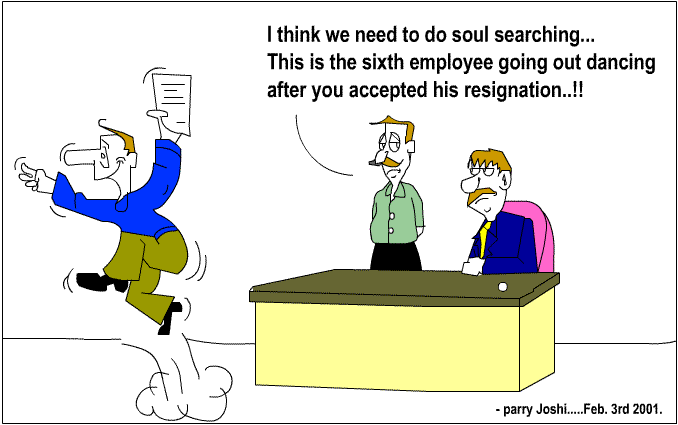Why Performance Appraisals are important?
 A well-written and well documented performance appraisal is of great importance in all organizations, no matter what type of business it is in. Employee appraisal can serve as a platform for employees to bring forth questions and concerns. This can help increase employee perseverance, creativity, and job satisfaction. Reviews allow the organizations to evaluate employees for increased responsibilities and future promotions. The PA acts as a road map for both organization and its employees.
A well-written and well documented performance appraisal is of great importance in all organizations, no matter what type of business it is in. Employee appraisal can serve as a platform for employees to bring forth questions and concerns. This can help increase employee perseverance, creativity, and job satisfaction. Reviews allow the organizations to evaluate employees for increased responsibilities and future promotions. The PA acts as a road map for both organization and its employees.
PAs help organizations with useful information such as employee’s skill, knowledge, capability their knowledge up gradation, attitude, aptitude, health changes if any etc. In fact PA helps to improve the communication system of the organization and to review the potentiality of employees so that their future capability is anticipated. It helps in setting marketing and sales goals, operational goals, outsourcing function, infrastructural capability, R&D etc.
Rank and Yank is a term used to describe a process by which a company ranks its employees against each other, and terminates the employment of the people at the lowest end of the ranking (that’s the yank). The term probably came into being to describe the process used at General Electric (GE), and is associated with former CEO Jack Welch. In his view, the real term was “differentiation.” He looked at appraisals for building great thorough consistency, transparency and openness. Welch has written that “It’s about aligning performance with the organization’s mission and values. It’s about making sure that all employees know where they stand.” What happens to the yanks? According to Welch, the employees at bottom line 10% employees (the poor performers) will never feel let down, when PAs are done on regular intervals and are transparent.
A transparent, ethical PA system is never demoralizing or inhuman. What’s inhumane is failing to make the organization’s standards and values clear and transparent and letting people know where they stand. According to Welch, managers owe frankness and sincerity to their subordinates; they must never create environment in which the subordinates keep guessing about what the organization thinks of them. Employees must know exactly what organization feels about them.
During the hiring process, recruiters and hiring managers must tell employees when and how they will receive performance appraisals. Employees trust employers to follow throughout all promises; from paying employees on time, to giving employees holidays, enhancing career, and timely evaluation of their performance. Therefore, conducting systematic and timely performance appraisals is an important consideration when it comes to placing value on the company’s human capital.
 Following are some specific tips for drafting better performance evaluations:
Following are some specific tips for drafting better performance evaluations:
- Be specific and avoid generalization: Phrases such as ‘maintain time limit’, ‘work harder,’ ‘increase production’ are not specific. They create ambiguity in minds of employees. Be specific by mentioning exactness. Such as ‘increase sales by 20% in the next three months,’ ‘you need to work from 9am to 5 pm,’ these are measurable objectives, and assist both the employee and employer.
- Focus on what you want the employee to do, not what you want him/her to be: A performance evaluation is not about finding flaws in an employee’s personality or discussing only weaknesses. You cannot change the employee’s basic personality traits in a performance evaluation. Managers must objectively state exactly what is expected out of the employee.
- Use real details: Use the correct and full name of the employee, his joining date, cadre, salary, exact designation, detailed duties, family background etc. Be specific. Be clear about his Key Result Areas (KRA) what is expected from the employee and the date it is expected. For documenting performance issues, get as detailed as possible instead of merely using phrases such as ‘is a trouble maker’ instead, document incidents where the employee’s attitude was inappropriate, stating the date, place, incident, witnesses, behavior(s), and the unfavorable effect of the employee’s conduct on those around him, as well as the specific organizational policies and procedures to be used when employee’s behavior is violated.
- Set only a limited number of objectives: The employee needs to be able to do the work; people can’t achieve an objective that is not within their scope of influence or current capability. The employee must have the tools, resources, and access required to get the work done. Expectations must be well defined, and the employee must have sufficient time and assistance to meet milestones. Remember, more than seven objectives are excessive.
- Appraisal biases: should be avoided as far as possible. In performance appraisal halo bias is termed as Matthew Effect. It is said to occur where employees tend to keep receiving the same appraisal results, year in and year out judged or based on an early performance evaluation. If an employee did well on the early evaluation, he will be more trusted than other employees and all of his work will be seen in a favorable light. If he did poorly, he will have a very hard time earning trust or a positive evaluation from his boss. Their appraisal results tend to become self-fulfilling: if they have done well, they will continue to do well; if they have done poorly, they will continue to do poorly. The Matthew Effect suggests that no matter how hard an employee strives, their past appraisal records will prejudice their future attempts to improve.
 Often organizations overlook importance of timely performance appraisal, though it is powerful for enhancing employee satisfaction and retention. The timely and accurate performance reviews are a key factor in retaining a satisfied and productive workforce. Feedback, whether positive or negative, can help employees understand the company’s expectations and perceptions and provides a pathway to improvement. Providing timely feedback lets good employees know you appreciate their accomplishments. While identifying what an employee can or needs to do better is a critical function of performance reviews, other equally critical yet often overlooked functions include showing the company’s appreciation for employees who are successful, showing passion and accountability for their work, and letting them know they are important to the success of the company.
Often organizations overlook importance of timely performance appraisal, though it is powerful for enhancing employee satisfaction and retention. The timely and accurate performance reviews are a key factor in retaining a satisfied and productive workforce. Feedback, whether positive or negative, can help employees understand the company’s expectations and perceptions and provides a pathway to improvement. Providing timely feedback lets good employees know you appreciate their accomplishments. While identifying what an employee can or needs to do better is a critical function of performance reviews, other equally critical yet often overlooked functions include showing the company’s appreciation for employees who are successful, showing passion and accountability for their work, and letting them know they are important to the success of the company.
Training and development is another area which can be used with help of PA. Training and development are used together to bring about the overall familiarization, improvement, and education of an organization’s employees. In general, training programs have very specific and quantifiable goals, such as operating a particular piece of machinery, understanding a specific process, or performing certain procedures with great precision. On the other hand, developmental programs concentrate on broader skills that are applicable to a wider variety of situations, such as decision making, leadership skills, and goal setting.
Google schedules their performance reviews twice a year; major one at the end of the year and a smaller one mid-year. Each review consists of a self-assessment, a set of peer reviews, and if an employee is applying for a promotion, reasons for why he should be promoted to the next level. Each review component is submitted via an online tool. Around performance review time, it’s not exceptional to see many engineers taking a day or more just to write the reviews through the tool. In the self-assessment, the employee summarizes his major accomplishments and contributions since the last review. He is asked to describe his strengths and areas for improvement; the employee is expected to frame them with respect to the job expectations described in his career ladder. For peer reviews, employees are expected to choose around 3-8 peers (fellow engineers, product managers, or others that can comment on their work) to write their peer reviews. Often, managers assign additional individuals to write peer reviews for one of their reports, particularly newer or younger employees who may be less familiar with the process are chosen. Peers comment on an employee’s contribution in a project, on his strengths, and on areas for improvement. If an employee applies for a promotion, the peer reviews become more relevant for considering his promotion.
An accurate performance reviews is critical because it helps exceptional employees being rewarded with exceptional performance ratings and the benefits that go along with those ratings, while poor performers should be rated and rewarded accordingly. Employees talk among themselves and share information. It can be extremely demoralizing for a high-performing employee to learn that marginal or poor performers have received the same rating, pay raise, and other benefits.
Finally, change is constant in business; the PA system should also change accordingly.












































